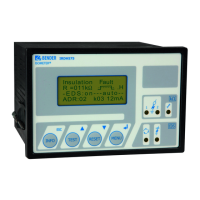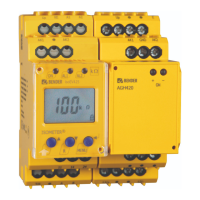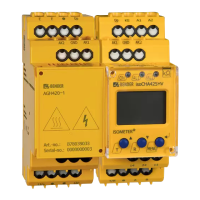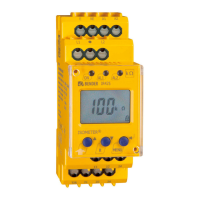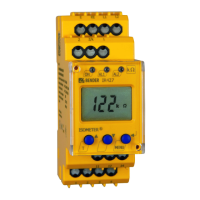Function
17
isoRW425_D00052_03_M_XXEN / 02.2017
The lower resistance component of R
F
or X
ce
determines the amount of Z
F
. The
higher resistance component of R
F
or X
ce
can have a higher tolerance due to
the measuring signal resolution.
If the insulation impedance Z
F
reaches or falls below the activated values Z1
or Z2, an alarm message will be signalled. If Z
F
exceeds the values Z1 or Z2 plus
the hysteresis value (Table Page 34), the alarm will be cleared.
3.2.3 Undervoltage/overvoltage monitoring
In the response value menu "AL" (Page 34), the parameters
(U < and U >) for monitoring the mains voltage can be activated or deactivat-
ed. The maximum undervoltage value is limited by the overvoltage value.
The r.m.s. value of the mains voltage is monitored. If the mains voltage U
n
reaches, falls below or exceeds the limit values (U < or U >), an alarm will be
signalled. If the maximum permissible system leakage capacitance set for the
ISOMETER® is exceeded, an alarm message will be initiated even when the
overvoltage limit value has been deactivated. The alarm will be deleted when
the limit values plus the hysteresis (Page 34) are no longer violated.
3.2.4 Self test/error codes
The integrated self-test function checks the function of the insulation moni-
toring device and the connection monitoring checks the connections to the
system to be monitored. The alarm relays are not switched during the self test.
This can be changed using the parameter "test" in the alarm assignment
(Chapter 5.4 Menu "out"). During the test, the display indicates "tES".
When malfunctions are detected or connections are missing, the LEDs ON/
AL1/AL2 flash. The respective error codes (E.xx) will be indicated on the dis-
play and the relay K2 switches.
The relays can be assigned to a device error with the parameter"Err" in the
"out" menu in the alarm assignment.
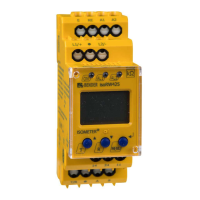
